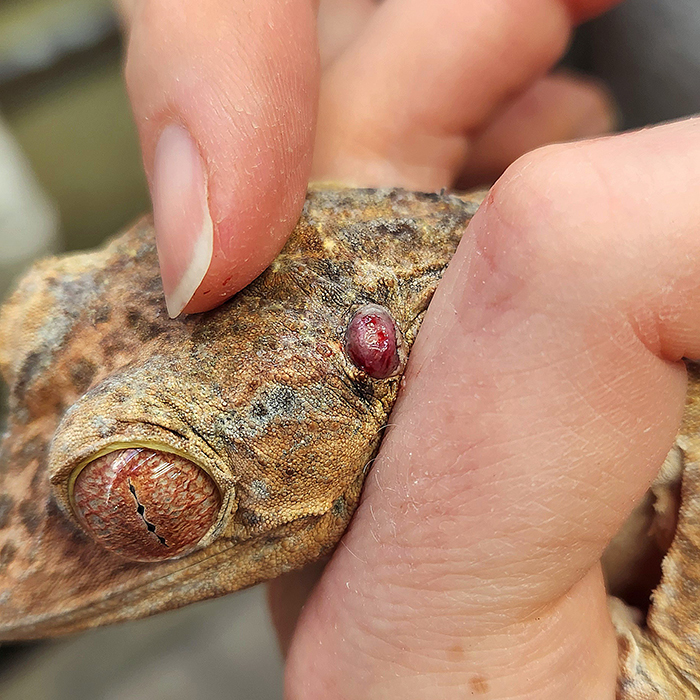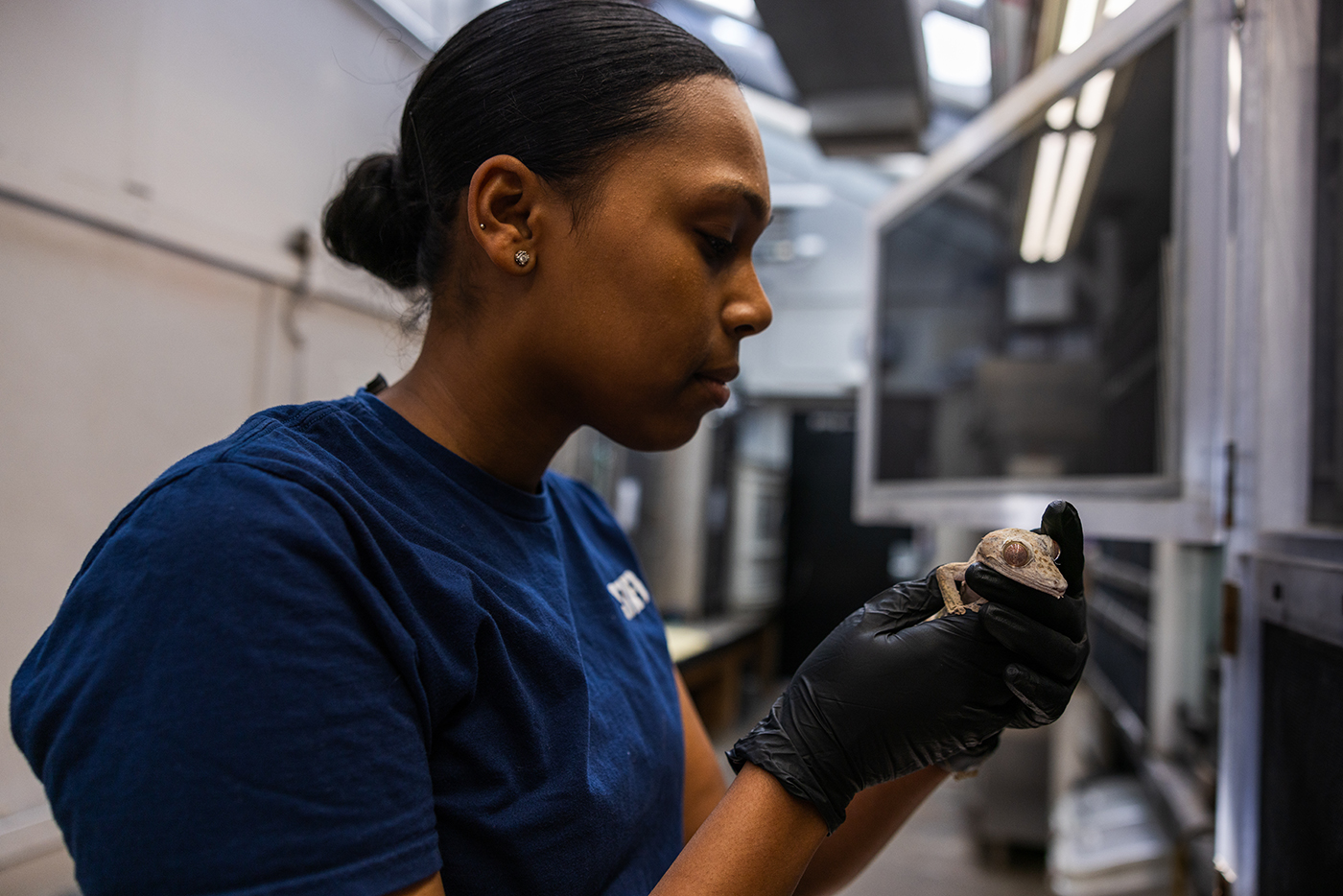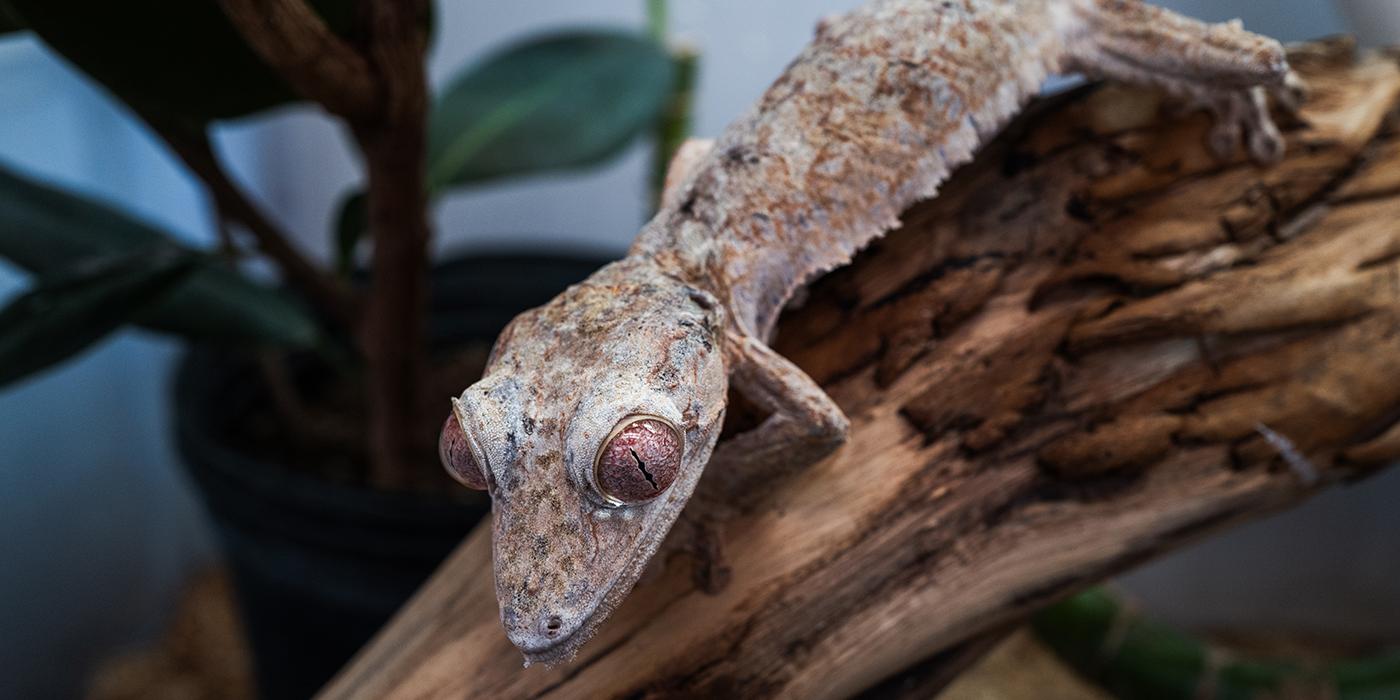Leaf-tailed Gecko Treated for Skin Cancer With Chemotherapy
Veterinarians performed cutting-edge treatment on a species at the fringes of zoo medicine
It started, as many cancers do, with a lump. Keepers at the Smithsonian’s National Zoo’s Reptile Discovery Center spotted it during a routine checkup—a small, discolored bulge on the neck of the 4-year-old Henkel’s leaf-tailed gecko. They were relieved when the gecko shed its skin and the lump disappeared—and became alarmed when it grew back, this time accompanied by a second growth and black spots.
The diagnosis: squamous cell carcinoma, a potentially deadly form of skin cancer.
What followed was an unusual medical journey—one that made the little gecko the first lizard ever treated with chemotherapy at the Smithsonian’s National Zoo. Today, its survival marks a milestone that Zoo veterinarians hope will push the boundaries of reptile medicine.
A rare opportunity for reptile care
The fight to save the unnamed gecko began soon after Zoo veterinarians Dr. Laci Taylor and Dr. James Steeil received the animal’s diagnosis. They were facing a dilemma.
Surgery to remove the growths is the standard treatment for this type of cancer, but there’s no guarantee the tumors wouldn’t simply grow back in a few months. Additional rounds of surgery would be disruptive, costly and painful. Plus, one of the tumors was located directly above the animal’s spine, which significantly raised the risk of complications.

Animal care team members examine a lesion on the lizard’s neck. (Smithsonian/Matt Evans)
On the other hand, going straight into palliative care felt premature: despite the growths, the gecko was healthy, active and behaving normally.
The team hit the books, conducting a literature review to discover how similar cases were treated.
Their search turned up a case study from 2019, in which a cockatiel with the same type of cancer was treated with an innovative chemotherapy regimen. The procedure called for an injectable chemotherapy drug called Bleomycin, used in combination with electrochemotherapy at the site of the affected tissue.
But even though other animals in zoo settings are sometimes treated with chemo, the Zoo team found no published record of a lizard ever undergoing this particular treatment, leading them to conclude it’s a scientific rarity.
Despite the uncertain outcome, all partners agreed that chemotherapy was the right approach.
Matt Evans, assistant curator of the Zoo’s Reptile Discovery Center exhibit, said the gecko’s agreeable personality was a major factor in the decision. Unlike some individuals, this gecko has a laid-back demeanor and didn’t seem to mind being handled, which led Evans to believe the animal would be less stressed during treatment.
“The growths could be painful. It wasn’t something we wanted to sit around and watch,” he said. “But this gecko was stable and healthy overall and doing all the normal things a gecko should. That made it easier for us to say, ‘okay, this animal’s pretty strong, let’s see.’”
Inside a reptile chemotherapy session
Administering chemotherapy to a 3-ounce lizard required some ingenuity from the vet care team.
First, the gecko was equipped with a tiny face mask to deliver anesthesia. Standard heart rate monitors wouldn’t have been able to pick up the animal’s tiny pulse, so vets monitored the patient’s heart rate using a sound-based Doppler probe.
The drug delivery method was affected, too. In many cases, chemotherapy drugs are administered through the veins, explained Dr. Taylor. “But the patient here is so teeny-tiny that we couldn’t confidently get access to the vein and make sure it’s not leaking out elsewhere.”
The bleomycin itself was injected directly into the tumors. Then, an electrochemotherapy device pulsed electricity into the affected tissue, opening cell membranes and increasing the amount of drug the cells took in.
The procedure was carried out by consulting veterinary oncologist Dr. Conor McNeill, who also advised on the procedure and provided the equipment and medication. After the growths were neutralized and treatment was completed, the vet team sutured the wounds and brought the gecko to the Zoo hospital’s recovery ward.
Back on four legs
One month after the procedure, the gecko is back to living in its behind-the-scenes enclosure at the Reptile Discovery Center. Keepers say the animal is eating a full diet, appears strong, and showing no signs of the lesions returning.

Dr. Laci Taylor examines the leaf-tailed gecko in April 2025. (Smithsonian/Roshan Patel)
Zoo teams are cautiously optimistic. If the treatment holds, it could add several healthy years to the lizard’s life. And maybe, it could serve as a valuable tool in the fight to treat cancer in animals that are often at the fringes of veterinary medicine.
“There’s a lot we don’t know about reptile medicine simply because most of these drugs haven’t been used on reptiles. If this treatment does its job, we’ll have a better idea how to move forward,” said Evans.
And to the veterinary team, the case exemplifies what it means to work in collaboration and go above and beyond for an animal.
“Working with the Zoo team is always scientifically interesting and professionally rewarding, because there’s such a learning curve and there’s so much creativity required,” said Dr. McNeil. “We all come at the problem from different angles and have different specialties, and everyone’s putting their contributions towards the same goal. Everyone wants the patient to be better, and for us to do the best job we can.”
“This was a true collaboration—not just within our institution, but with specialists across the field,” said Dr. Steeil. “It’s exciting to help progress zoological medicine in a direction that will benefit patients down the road.”
Subscribe to the National Zoo News for monthly updates about animal care and conservation science, delivered straight to your inbox.

